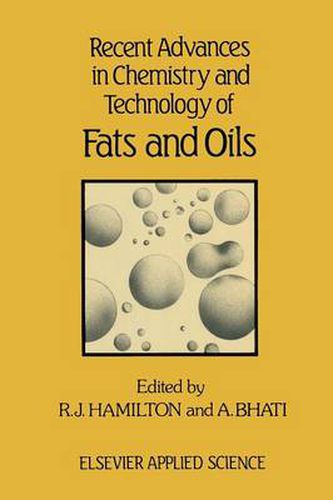Readings Newsletter
Become a Readings Member to make your shopping experience even easier.
Sign in or sign up for free!
You’re not far away from qualifying for FREE standard shipping within Australia
You’ve qualified for FREE standard shipping within Australia
The cart is loading…






This title is printed to order. This book may have been self-published. If so, we cannot guarantee the quality of the content. In the main most books will have gone through the editing process however some may not. We therefore suggest that you be aware of this before ordering this book. If in doubt check either the author or publisher’s details as we are unable to accept any returns unless they are faulty. Please contact us if you have any questions.
Since we produced Fats and Oils: Chemistry and Technology in 1980, the trend we anticipated to up-date the classical texts of oils and fats has manifested itself. Bailey’s famous textbook has been completely revised and a second edition of Bernardini’s work has been produced. The present text is an attempt to provide some insight into the current state of the art. Chapter 1 discusses the physical properties of oils and fats with special reference to those properties which can be monitored to give an in dication of the suitability of fats for chocolate production. The physical properties of the fats are often determined by the order in which the fatty acids are attached to the glyceride molecule. Ram Bhati, in the last article he wrote before his death, showed how mass spectrometry and chemical methods could be used to determine the sequence of fatty acids. Ram’s essentially practical approach to the problem is exemplified by the section dealing with the experimental details of the techniques. Chapter 3 outlines some of the problems which can arise in industry when the lipid part of a foodstuff undergoes oxidation, whilst in Chapter 4 Patterson describes the major technique, hydrogenation, which is used to circumvent the problems caused by oxidation of the unsaturated fatty acids. In Chapter 4 the essentials of the theory are given to enable the reader to appreciate the design features of the apparatus. Chapter 5 deals with the analysis, mainly chromatographic, of lipids.
$9.00 standard shipping within Australia
FREE standard shipping within Australia for orders over $100.00
Express & International shipping calculated at checkout
This title is printed to order. This book may have been self-published. If so, we cannot guarantee the quality of the content. In the main most books will have gone through the editing process however some may not. We therefore suggest that you be aware of this before ordering this book. If in doubt check either the author or publisher’s details as we are unable to accept any returns unless they are faulty. Please contact us if you have any questions.
Since we produced Fats and Oils: Chemistry and Technology in 1980, the trend we anticipated to up-date the classical texts of oils and fats has manifested itself. Bailey’s famous textbook has been completely revised and a second edition of Bernardini’s work has been produced. The present text is an attempt to provide some insight into the current state of the art. Chapter 1 discusses the physical properties of oils and fats with special reference to those properties which can be monitored to give an in dication of the suitability of fats for chocolate production. The physical properties of the fats are often determined by the order in which the fatty acids are attached to the glyceride molecule. Ram Bhati, in the last article he wrote before his death, showed how mass spectrometry and chemical methods could be used to determine the sequence of fatty acids. Ram’s essentially practical approach to the problem is exemplified by the section dealing with the experimental details of the techniques. Chapter 3 outlines some of the problems which can arise in industry when the lipid part of a foodstuff undergoes oxidation, whilst in Chapter 4 Patterson describes the major technique, hydrogenation, which is used to circumvent the problems caused by oxidation of the unsaturated fatty acids. In Chapter 4 the essentials of the theory are given to enable the reader to appreciate the design features of the apparatus. Chapter 5 deals with the analysis, mainly chromatographic, of lipids.